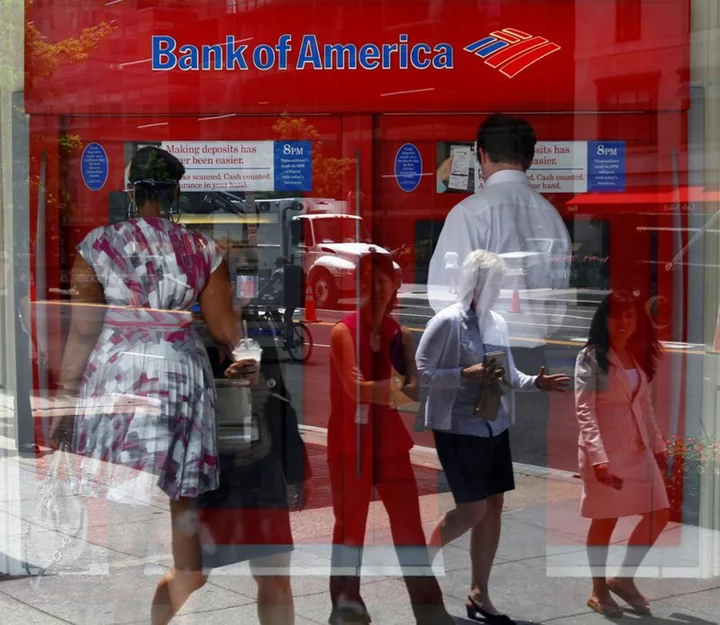By Nupur Anand, Niket Nishant and Saeed Azhar
NEW YORK Wall Street banks are expected to report higher profits for the second quarter as rising interest payments offset a downturn in dealmaking.
For universal banks such as JPMorgan and Wells Fargo that serve retail consumers as well as corporations, earnings per share (EPS) are expected to jump more than 40%, according to analyst estimates from Refinitiv I/B/E/S as of late Monday. Bank of America's EPS will likely climb more than 7%. Citigroup is expected to lag its peers with a 43% drop in EPS.
Results for investment banking behemoths will also weaken, with EPS forecast to drop almost 59% at Goldman Sachs. Morgan Stanley's EPS is anticipated to drop 9%, although revenue from wealth management will likely cushion the blow from lackluster dealmaking.
Universal lenders have been buoyed by American consumers who continue to spend money and remain in good financial health, said David Konrad, an analyst at Keefe, Bruyette & Woods. That offsets the doldrums in investment banking, where revenues have been depressed by rising interest rates and economic uncertainty.
"Goldman will have a dismal quarter again for investment banking and trading has been lackluster due to lower volatility," said Stephen Biggar, an analyst at Argus Research. The bank will probably take a writedown on its consumer business, he added.
Sluggish deal markets will continue to be a sore spot for Wall Street after global investment banking activity plunged to $15.7 billion in the second quarter, the lowest since 2012, according to Dealogic data.
Banking executives have also lowered expectations for the second quarter after mergers, acquisitions and debt offerings plunged in recent months. But some have pointed to a nascent revival in initial public offerings as a sign of a potential recovery in equity capital markets for the second half.
When interest rates rise, lenders typically earn more from charging customers higher borrowing rates. But demand for loans is slowing, and banks are paying up to keep consumers' money parked in accounts while customers shop around for higher-yielding options.
Deposits fell $141 billion at large lenders in the second quarter, KBW analysts said in a note. That outflow reversed an influx of deposits into big banks in the first quarter as customers sought safety after several regional banks collapsed.
Looking ahead, banks may pull back on lending in preparation for new rules that could require them to hold more capital. U.S. banking giants sailed through the Fed's annual health check in June, showing they had enough capital to weather a severe economic downturn. The lenders raised their dividends after the results were announced.
The U.S. added fewer jobs than anticipated in June, but wage growth and employment are still strong. The hot job market will likely keep the Federal Reserve on track to raise interest rates in July, according to traders' expectations.
Analysts and investors will also focus on executives' commentary on loan growth and credit quality, said Betsy Graseck, an analyst at Morgan Stanley.
"It's a double-edged sword," she said. "The good news is credit is good, but the bad news is that this could mean rates need to go even higher," she said.
While consumer finances have held up so far, default risks on personal loans and credit cards are predicted to rise, Kenneth Leon, research director at CFRA Research, wrote in a note.
"We see higher credit risk ahead for lower to middle class families with higher credit card debt that cannot keep pace with higher living costs," Leon added.
Office loans also pose concerns for some U.S. lenders, as property values decline and more borrowers default, analysts said. Investors will focus on any provisions banks set aside for souring loans on commercial real estate (CRE).
"Credit losses for the large banks are expected to be modest in CRE this quarter, but there could be bigger reserve build that we can see as uncertainty is very high," Konrad said.
The S&P 500 banks index has fallen 9.3% this year, underperforming the S&P 500 index which has notched a 14.6% gain.
(Reporting by Nupur Anand and Saeed Azhar in New York; Niket Nishant in Bengaluru; Editing by Lananh Nguyen and Marguerita Choy)

